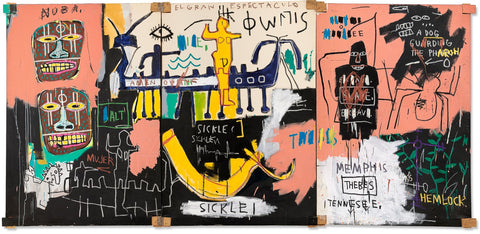The Market Turbulence of Jean‐Michel Basquiat
Few scenarios identify an artist as an outstanding commercial success or a perilous market bubble quite like having their works headlining both Sotheby’s and Christie’s spring sales simultaneously. Jean-Michel Basquiat is among the select few artists who have achieved this feat. His two most recognizable paintings still in private collections, 'El Gran Espectaculo (The Nile)' and 'Now’s the Time', are estimated to sell for $45m at Christie’s and $30m at Sotheby’s, respectively.
These high prices demonstrate the continued allure and appreciation for Basquiat's art, and the undeniable market demand for his unique style. The sale of these two paintings also represents a rare opportunity for art collectors to acquire original pieces by one of the most iconic and influential artists of the 20th century.
Basquiat's work remains as relevant today as it was during his lifetime, continuing to inspire new generations of artists and collectors alike. With his unapologetic approach to street art and his keen insight into the complexities of race, class, and identity, Basquiat has cemented his place in art history as a true visionary.

El Gran Espectaculo (The Nile), 1983
Acrylic and oilstick on canvas mounted on wooden supports, in three parts
172.7 x 358 cm

Jean-Michel Basquiat
Now's the Time, 1985
Acrylic and oilstick on wood
234.3 x 236.9 cm
Jean-Michel Basquiat began his artistic career under the pseudonym SAMO and was a prominent member of the social circle surrounding the Mudd Club, the iconic night club and gallery hybrid that defined the downtown scene in the 1980s. In 1981, Basquiat was featured in a group exhibition called "New York/New Wave" curated by Mudd Club co-founder Diego Cortez, which catapulted the 21-year-old street artist into the public eye.
Drawing on his Caribbean heritage and a blend of African American, African, and Aztec cultural histories, Basquiat's work often incorporated elements of pop culture. His signature style, influenced by his early days as a graffiti artist, features bold lines, zingy one-liners, and distinctive symbols.
Despite his meteoric rise to fame, Basquiat never lost touch with his roots and remained committed to exploring themes related to race, class, and identity throughout his career. His unique perspective and unapologetic approach to art continue to inspire artists and art enthusiasts alike, cementing his place as one of the most influential and enduring artists of the 20th century.
Since Jean-Michel Basquiat's untimely death at the age of 27 in 1988, the market for his artwork has continued to expand, with growing demand and skyrocketing prices. In fact, his work has become increasingly sought-after over the last 35 years.
At auction, Basquiat's art has commanded some of the highest prices in the history of contemporary art. In 2017, a skull painting from 1982, untitled, sold for a staggering $110.5m (including fees) to Japanese billionaire Yusaku Maezawa at Sotheby's New York, setting a new record for the artist's work.

Untitled (1982)
Acrylic, spray paint and oilstick on canvas
183.2 x 173 cm
This incredible sale, along with the continued success of Basquiat's artwork, highlights the enduring appeal of his unique style and the ongoing fascination with his powerful artistic vision. His legacy has cemented his position as one of the most significant and influential artists of his generation, inspiring generations of artists and collectors to come.

Jean-Michel Basquiat
Rome Pays Off, 2004
Screenprint in colours on museum board
111.6 × 101 cm
Edition of 85
“The genius of Basquiat is undeniable. His presence and influence break boundaries, spanning fashion, art, and pop culture. The impact that he continues to have on culture is inescapable, and only continues to expand,” Alex Rotter, Christie’s chairman of 20th and 21st-century art, said in a statement.
While the market for Basquiat's work has been strong in recent years, there are indications that it may not be as stable as it seems. According to a report by Katya Kazakina of Artnet News Pro, the artist's auction revenue fell by 50% in 2022, a steep decline from its peak just a year prior.
This sudden drop in revenue could be a result of market fatigue brought on by the overexposure of Basquiat's work, or it could be due to the inevitable shortage of top-tier works available for sale. Regardless of the reason, the upcoming auctions will provide insight into whether the Basquiat market is experiencing a momentary setback or is in the midst of a downturn era.
It's interesting to ponder how the artist himself, who was acutely aware of self-marketing and the commercialization of art, would have felt about this turbulence. Nevertheless, this case serves as a perfect illustration of the periodic ups and downs that art markets go through. If the market is indeed down right now, it presents an opportunity for collectors to invest in valuable Basquiat pieces for less.
Despite the current market fluctuations, there is no doubt that Basquiat's influence and legacy will continue to endure, inspiring future generations of artists and art collectors alike.


